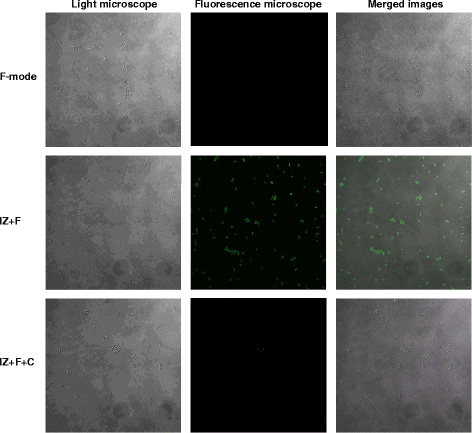The bactericidal effect of an ionizer under low concentration of ozone
- PMID: 27475908
- PMCID: PMC4967512
- DOI: 10.1186/s12866-016-0785-5
The bactericidal effect of an ionizer under low concentration of ozone
Abstract
Background: Several mechanisms have been suggested for the bactericidal action of ionizers including electrical phenomena, effects of negative and positive ions and electrostatic repulsion. Negative and positive ions have indeed been shown to have bactericidal effects. In addition, since ozone is generated along with ions, these may contribute to the bacterial killing. In this study, we used a newly developed ionizer, which generates a relatively low concentration of ozone, to determine whether its effect on bacterial cells were due to ions or ozone, and, if ions, how the ions exerted their effects.
Results: The effect of ions on bacterial killing was compared with that of the ozone produced using an ion trap to remove the ions. The ionizer had the ability to kill the bacteria, and ion capture dramatically reduced its bactericidal effect, indicating that the ozone generated had little or no bactericidal effect under these conditions, and the ions produced were responsible for almost all the bacterial killing. Operation of the ionizer increased the level of 8-oxo-dG, a marker of oxidative DNA damage, and decreased aconitase activity, which is known to be sensitive to ROS. The ionizer further affected the adenylate energy charge of bacterial cells. Removal of the ions with the ion trap greatly reduced all these effects.
Conclusion: These results indicate that negative and positive ions generated by the ionizer are responsible for inducing oxidative stress and so reducing bacterial survival.
Keywords: Bactericidal effect; Ionizer; Low concentration of ozone; Negative and positive ions; ROS.
Figures





Similar articles
-
Positive and Negative Ions Potently Inhibit the Viability of Airborne Gram-Positive and Gram-Negative Bacteria.Microbiol Spectr. 2021 Dec 22;9(3):e0065121. doi: 10.1128/Spectrum.00651-21. Epub 2021 Nov 10. Microbiol Spectr. 2021. PMID: 34756075 Free PMC article.
-
The application of ionizers in domestic refrigerators for reduction in airborne and surface bacteria.J Appl Microbiol. 2009 Dec 1;107(6):1789-98. doi: 10.1111/j.1365-2672.2009.04359.x. Epub 2009 Apr 25. J Appl Microbiol. 2009. PMID: 19486210
-
Effect of negative air ions on the potential for bacterial contamination of plastic medical equipment.BMC Infect Dis. 2010 Apr 12;10:92. doi: 10.1186/1471-2334-10-92. BMC Infect Dis. 2010. PMID: 20384999 Free PMC article.
-
Bactericidal action of positive and negative ions in air.BMC Microbiol. 2007 Apr 17;7:32. doi: 10.1186/1471-2180-7-32. BMC Microbiol. 2007. PMID: 17439657 Free PMC article.
-
Bactericidal effects of negative air ions on airborne and surface Salmonella enteritidis from an artificially generated aerosol.J Food Prot. 2001 Jan;64(1):113-6. doi: 10.4315/0362-028x-64.1.113. J Food Prot. 2001. PMID: 11198431
Cited by
-
Portable and affordable cold air plasma source with optimized bactericidal effect.Sci Rep. 2024 Jul 10;14(1):15930. doi: 10.1038/s41598-024-66017-w. Sci Rep. 2024. PMID: 38987305 Free PMC article.
-
Positive and Negative Ions Potently Inhibit the Viability of Airborne Gram-Positive and Gram-Negative Bacteria.Microbiol Spectr. 2021 Dec 22;9(3):e0065121. doi: 10.1128/Spectrum.00651-21. Epub 2021 Nov 10. Microbiol Spectr. 2021. PMID: 34756075 Free PMC article.
-
Rationale for ozone-therapy as an adjuvant therapy in COVID-19: a narrative review.Med Gas Res. 2020 Jul-Sep;10(3):134-138. doi: 10.4103/2045-9912.289462. Med Gas Res. 2020. PMID: 33004712 Free PMC article. Review.
-
Synergistic graphene-MnOx/honeycomb activated carbon (G-MnOx/HAC) and plasma technology for eradication of pathogenic microorganisms.Front Chem. 2023 Aug 2;11:1207947. doi: 10.3389/fchem.2023.1207947. eCollection 2023. Front Chem. 2023. PMID: 37601903 Free PMC article.
-
Use of Ozone in Veterinary Dentistry as an Alternative to Conventional Antibiotics and Antiseptics.Vet Sci. 2024 Apr 3;11(4):163. doi: 10.3390/vetsci11040163. Vet Sci. 2024. PMID: 38668430 Free PMC article.
References
-
- Noyce JO, Hughes JF. Bactericidal effects of negative and positive ions generated in nitrogen on Escherichia coli. J Electrostatics. 2002;54(2):179–87. doi: 10.1016/S0304-3886(01)00179-6. - DOI
-
- Noyce JO, Hughes JF. Bactericidal effects of negative and positive ions generated in nitrogen on starved Pseudomonas veronii. J Electrostatics. 2003;57(1):49–58. doi: 10.1016/S0304-3886(02)00110-9. - DOI
-
- Marin V, Moretti G, Rassu M. Effects of ionization of the air on some bacterial strains. Ann Ig. 1988;1(6):1491–500. - PubMed
MeSH terms
Substances
LinkOut - more resources
Full Text Sources
Other Literature Sources
Medical
Molecular Biology Databases

